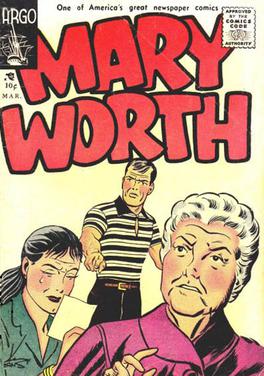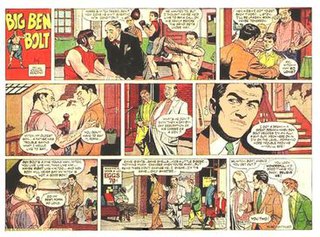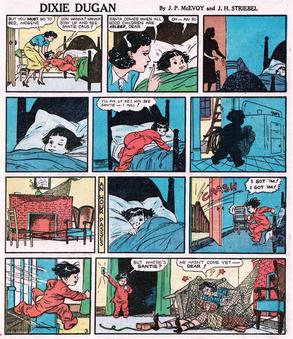
Mary Worth is an American newspaper comic strip that has had an eight-decade run from 1938. Distributed by King Features Syndicate, this soap opera-style strip influenced several that followed. It was created by writer Allen Saunders and artist Dale Connor, and initially appeared under the pseudonym "Dale Allen". Ken Ernst succeeded Connor as artist in 1942.

Rex Morgan, M.D. is an American soap opera comic strip, created May 10, 1948 by psychiatrist Dr. Nicholas P. Dallis under the pseudonym Dal Curtis.
Don Markstein's Toonopedia is an online encyclopedia of print cartoons, comic strips and animation, initiated February 13, 2001. Donald D. Markstein, the sole writer and editor of Toonopedia, termed it "the world's first hypertext encyclopedia of toons" and stated, "The basic idea is to cover the entire spectrum of American cartoonery."
United Feature Syndicate, Inc. (UFS) is a large American editorial column and comic strip newspaper syndication service based in the United States and established in 1919. Originally part of E. W. Scripps Company, it was part of United Media from 1978 to 2011, and is now a division of Andrews McMeel Syndication. United Features has syndicated many notable comic strips, including Peanuts, Garfield, Li'l Abner, Dilbert, Nancy, and Marmaduke.

Nicholas Peter Dallis, was an American psychiatrist turned comic strip writer, creator of the soap opera-style strips Rex Morgan, M.D., Judge Parker and Apartment 3-G. Separating his comics career from his medical practice, he wrote under pseudonyms, Dal Curtis for Rex Morgan, M.D. and Paul Nichols for Judge Parker.

Kerry Drake is the title of a comic strip created for Publishers Syndicate by Alfred Andriola as artist and Allen Saunders as uncredited writer. It debuted on Monday, October 4, 1943, replacing Norman Marsh's Dan Dunn, and was syndicated continuously through June 26, 1983.

Big Ben Bolt is a comic strip that was syndicated from February 20, 1950 to April 15, 1978. It was drawn by John Cullen Murphy, written by Elliot Caplin, and distributed by King Features Syndicate. The strip followed the adventures of boxer and journalist Ben Bolt.

Publishers-Hall Syndicate was a newspaper syndicate founded by Robert M. Hall in 1944. Hall served as the company's president and general manager. Over the course of its operations, the company was known as, sequentially, the Hall Syndicate (1944–1946), the New York Post Syndicate (1946–1949), the Post-Hall Syndicate (1949–1955), the Hall Syndicate (1955–1967), and Publishers-Hall Syndicate (1967–1975). The syndicate was acquired by Field Enterprises in 1967, and merged into Field Newspaper Syndicate in 1975. Some of the more notable strips syndicated by the company include Pogo, Dennis the Menace, Funky Winkerbean, Mark Trail, The Strange World of Mr. Mum, and Momma, as well as the cartoons of Jules Feiffer.

Dixie Dugan is best known as a long-running syndicated newspaper comic strip published from October 21, 1929 to October 8, 1966. The title character was originally modeled after 1920s film actress Louise Brooks and early stories followed Dixie's exploits as a Hollywood showgirl.

Gordon G. Rogers, better known as Boody Rogers, was an American comic strip and comic book cartoonist who created the superhero parody Sparky Watts.

Francis A. "Fran" Matera was an American comic strip artist best known for his King Features Syndicate adventure strip Steve Roper and Mike Nomad from 1984 to 2004. In addition to his extensive experience in newspaper strips, Matera also spent many years in the comic book industry, particularly for Charlton Comics. His influences include Hal Foster, Alex Raymond, Milton Caniff, Al Capp, and Bud Fisher.
Sam and Silo is an American comic strip created by Mort Walker and Jerry Dumas, which began on April 18, 1977. The series is a "continuation" or a spin-off of Sam's Strip (1961-1963), as it uses the same characters. Dumas was solely responsible for the strip from 1995 and drew it until his death in 2016.

Allen Saunders was an American writer, journalist and cartoonist who wrote the comic strips Steve Roper and Mike Nomad, Mary Worth and Kerry Drake.
William Overgard, was an American cartoonist and writer with a diverse opus, including novels, screenplays, animation, and the comic strips Steve Roper and Mike Nomad and Rudy.

Pete Hoffman was an American cartoonist. He is known for his work on the adventure strips Steve Roper and Jeff Cobb.
Elmer Woggon, who signed his art Wog, was the creator of an early newspaper comic strip that eventually developed into the long-running Steve Roper and Mike Nomad.

William Woggon was an American cartoonist who created the comic book Katy Keene.

Kenneth Fredrick Ernst was a US comic book and comic strip artist. He is most notable for his work on the popular and long-running comic strip Mary Worth from 1942 to 1985. With his realistic style, uncommon in those early years, Ernst paved the way for soap opera strips that followed.
Dateline: Danger! is an American syndicated newspaper comic strip published from November 11, 1968 to March 17, 1974, created and produced by writer John Saunders and artist Al McWilliams. The series, about two intelligence agents working undercover as reporters, co-starred the character Danny Raven, the first African-American lead character of a mainstream comic strip.
Publishers Newspaper Syndicate was a syndication service based in Chicago that operated from 1925 to 1967, when it merged with the Hall Syndicate. Publishers syndicated such long-lived comic strips as Big Chief Wahoo/Steve Roper, Mary Worth, Kerry Drake, Rex Morgan, M.D., Judge Parker, and Apartment 3-G.












